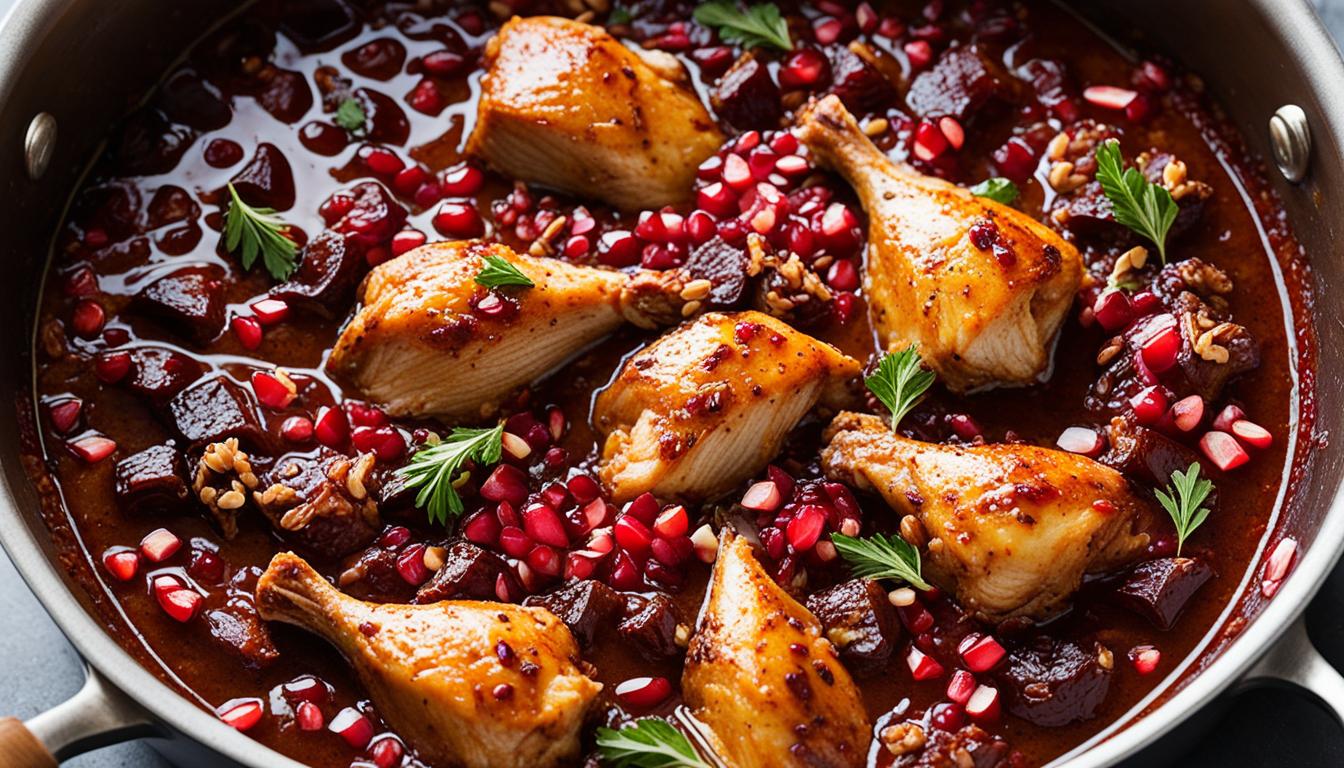Are you ready to embark on a culinary journey to discover the rich and complex flavors of Persian cuisine? Today, we invite you to explore the tantalizing world of fesenjan, a traditional Persian stew that will take your taste buds on an unforgettable adventure.
Fesenjan is a labor of love, a dish that requires time and patience to achieve perfection. This sumptuous meat braise combines fall-off-the-bone tender chicken with a nutty, rich, sweet, and sour sauce made from pomegranate molasses and crushed walnuts. The result? A harmonious blend of flavors that will leave you craving more.
Key Takeaways:
- Uncover the traditional secrets of authentic Persian cuisine
- Discover the unique flavor profile of fesenjan
- Learn the origin and cultural significance of this cherished dish
- Master the art of cooking fesenjan with step-by-step instructions
- Explore variations of fesenjan to suit your personal taste
The Origins of Fesenjan
Fesenjan, a traditional Iranian dish, holds deep roots in the Gilan province of northern Iran. This lush region is renowned for its abundant cultivation of pomegranate and walnut trees, making them integral components in many local delicacies. Amongst these culinary treasures, Fesenjan shines as a timeless favorite.
Fesenjan’s connection to the region extends beyond its ingredients. This divine dish occupies a special place in Iranian culture, particularly during the Winter Solstice, known as Shabe Yaldā. This joyful festival commemorates the triumph of light over darkness and the renewal of the sun’s energy. As a symbolic fruit during this celebration, pomegranates take center stage, and Fesenjan becomes a culinary tribute to this auspicious occasion.
Learn more about the story and unique characteristics of Fesenjan in the following section.
| Keyword | Definition |
|---|---|
| Traditional Iranian Fesenjan | A classic Persian dish, combining the richness of walnuts and the tanginess of pomegranates, originating from the Gilan province in northern Iran. |
| Fesenjan Originates from Gilan Province | Fesenjan finds its roots in the fertile Gilan province of northern Iran, renowned for its abundance of pomegranate and walnut trees. |
| Fesenjan and the Winter Solstice | Fesenjan holds great significance during the Winter Solstice, a festive celebration known as Shabe Yaldā, which symbolizes the victory of light over darkness. |
Ingredients for Fesenjan
When it comes to cooking a delicious Fesenjan, it’s essential to gather the right ingredients. Here are the key components that make up this delectable Persian dish:
- Walnuts: Finely ground walnuts are the star of the show in Fesenjan, creating a creamy and indulgent sauce.
- Onion: The fresh aroma and subtle sweetness of onions add depth of flavor to the dish.
- Chicken Thighs: Tender and juicy chicken thighs are the preferred choice for Fesenjan, but you can also use drumsticks or quarters.
- Pomegranate Molasses: This vital ingredient not only adds a delightful tanginess but also helps balance the richness of the walnuts.
- Sugar: A touch of sugar enhances the overall taste by adding a hint of sweetness to complement the savory flavors.
- Spices: Spices like turmeric, cinnamon, and saffron are used to infuse warmth and depth of flavor into the dish.
To elevate the taste profile, a pinch of salt and black pepper is added for that perfect balance of seasoning. With this array of ingredients, your Fesenjan will come to life, offering a harmonious blend of nuttiness, tanginess, and aromatic spices.
Ingredient Quantity
| Ingredients | Quantity |
|---|---|
| Walnuts | 1 cup, finely ground |
| Onion | 1 large, finely chopped |
| Chicken Thighs | 6 pieces, bone-in and skin-on |
| Pomegranate Molasses | 1/2 cup |
| Sugar | 2 tablespoons |
| Turmeric | 1 teaspoon |
| Cinnamon | 1/2 teaspoon |
| Saffron | 1/4 teaspoon, dissolved in 1 tablespoon hot water |
| Salt | To taste |
| Black Pepper | To taste |

An enticing mix of ingredients that go into making a flavorful Fesenjan
With these ingredients at your disposal, you’re ready to embark on a culinary journey to create a mouthwatering Fesenjan that will leave your taste buds craving for more.
Cooking Fesenjan
Cooking fesenjan involves a series of steps to achieve the perfect flavor and texture. Follow these simple instructions to make a delicious fesenjan stew:
- Grind the walnuts: Start by grinding the walnuts in a food processor until they are finely textured. This will help create a creamy and smooth sauce.
- Toast the walnuts: Lightly toast the ground walnuts in a dry skillet over medium heat. Toasting enhances their flavor and adds a nutty aroma to the dish.
- Caramelize the onions: Cook the onions in a separate skillet until they are golden and caramelized. This step adds depth and richness to the sauce.
- Create the walnut sauce: Combine the caramelized onions with the ground walnuts to create a creamy sauce. Stir well to ensure the flavors are evenly distributed.
- Sear and simmer the chicken: In a large pot, sear chicken thighs until they are golden brown. Then, add water, cinnamon, and spices to the pot and simmer the chicken until it becomes tender and juicy.
- Add the walnut sauce: Pour the ground walnut sauce into the pot with the cooking liquid. Simmer the mixture for about an hour to allow the flavors to meld together and the sauce to thicken.
- Balance the flavors: To balance the flavors of the stew, add pomegranate molasses, sugar, and saffron to the sauce. Adjust the sweetness and sourness according to your taste preference.
- Simmer until tender: Return the seared chicken to the pot and let the stew simmer for another 45 minutes. This will ensure the chicken is fall-off-the-bone tender and fully infused with the flavors of the sauce.
Once the cooking process is complete, your fesenjan stew is ready to be enjoyed. The rich and savory flavors of the walnuts, pomegranate molasses, and tender chicken will delight your taste buds. Serve it over basmati rice, saffron rice, or tahdig, and garnish with fresh pomegranate seeds for an extra burst of flavor.
Serving and Storing Fesenjan
Once you have prepared this delicious Persian stew, it’s time to serve and store it properly to preserve its flavors. Here are some tips on how to serve fesenjan and suggestions for accompaniments, along with guidelines for storing the leftovers.
How to Serve Fesenjan
Fesenjan is traditionally served over basmati rice, saffron rice, or tahdig, which is a crispy Persian rice cake. The fluffy rice acts as a perfect bed for the rich and flavorful stew. The combination of tender chicken, creamy walnut and pomegranate sauce, and fragrant rice creates a harmonious blend of textures and tastes.
Try These Serving Suggestions:
- Pair fesenjan with a vegetable-rich side dish like tabouli or a simple Mediterranean salad to add freshness and balance to the meal.
- Sprinkle some fresh pomegranate seeds over the stew before serving to add a burst of tangy sweetness and a vibrant visual appeal.

“Fesenjan is a culinary masterpiece that marries the flavors of pomegranate and walnuts with succulent chicken. Each spoonful is a delightful symphony of sweet, sour, and nutty notes. The addition of fresh pomegranate seeds not only brings a burst of freshness but also elevates the dish visually.”
Storing Fesenjan
If you have leftovers or want to prepare fesenjan in advance, it’s important to store it properly to maintain its taste and quality. Here are some guidelines:
- Transfer any leftover fesenjan to an airtight container and store it in the refrigerator. It will stay fresh for up to 4 days.
- If you want to extend the shelf life, fesenjan can also be frozen for up to 3 months. Freezing is a great option if you’re planning to make a larger batch or want to save some for later.
- When ready to enjoy your frozen fesenjan, make sure to defrost it completely in the refrigerator before reheating.
- Reheat the fesenjan on the stovetop or in the microwave until heated through. Stir it occasionally to ensure even heat distribution.
By following these serving and storage tips, you can fully enjoy the flavors of fesenjan without any compromise.
Variations of Fesenjan
While chicken is the most common protein used in fesenjan, the dish was originally made with duck. Some variations of fesenjan use vegetables such as pumpkin, butternut squash, or eggplant instead of meat. The sweetness and sourness of the dish can be adjusted to personal taste by adding more pomegranate molasses for sourness or sugar for sweetness. Each family and region in Iran may have their own unique version of fesenjan, resulting in a wide range of flavor profiles.
Conclusion
Fesenjan is a beloved dish in Persian cuisine, known for its rich and complex flavors. The combination of walnuts, pomegranate molasses, and tender chicken creates a unique and indulgent experience. This traditional stew is often reserved for special occasions and is cherished by Iranians around the world. With its earthy, sweet, and sour flavor profile, fesenjan offers a taste of authentic Persian cuisine.
The origins of fesenjan can be traced back to the Gilan province in northern Iran, where the abundance of pomegranate and walnut trees inspired the creation of this flavorful dish. It is deeply intertwined with Iranian culture and is often prepared during the Winter Solstice, a festival that celebrates the victory of light over darkness. Fesenjan holds great significance during this festive time, making it a true representation of tradition and heritage.
When cooking fesenjan, it is important to finely grind the walnuts and caramelize the onions to create a creamy and flavorful base. The chicken is then simmered in a mixture of water, spices, and the ground walnut sauce, allowing the flavors to meld together. The addition of pomegranate molasses, sugar, and saffron adds a perfect balance of sweetness and sourness to the dish.
Whether served over fragrant basmati rice or alongside a refreshing salad, fesenjan brings forth the essence of Persian cuisine. This tantalizing stew has delighted palates for generations and continues to be a cherished and timeless dish. So, why not embark on a culinary journey and savor the rich flavors of fesenjan, transporting your taste buds to the heart of Iran.
